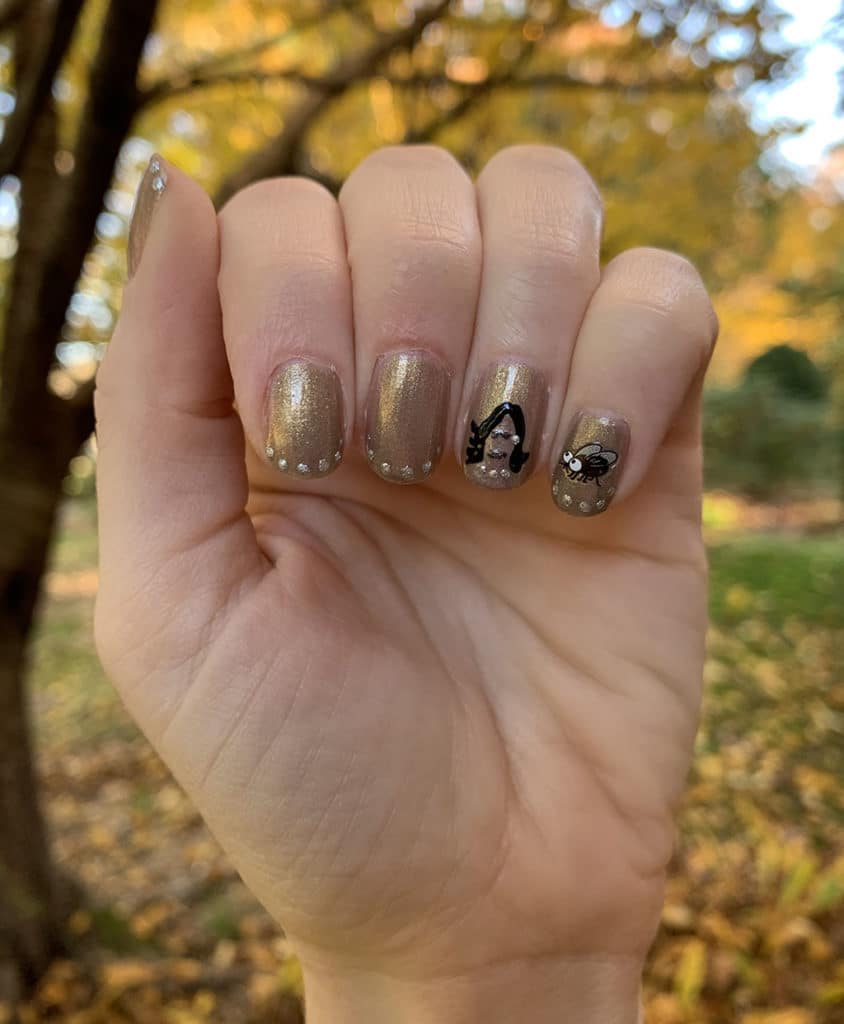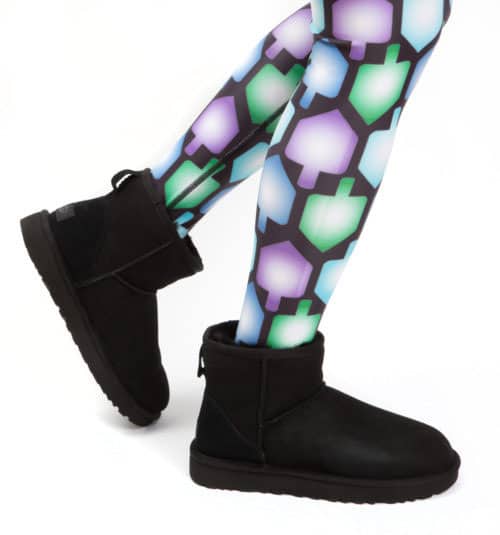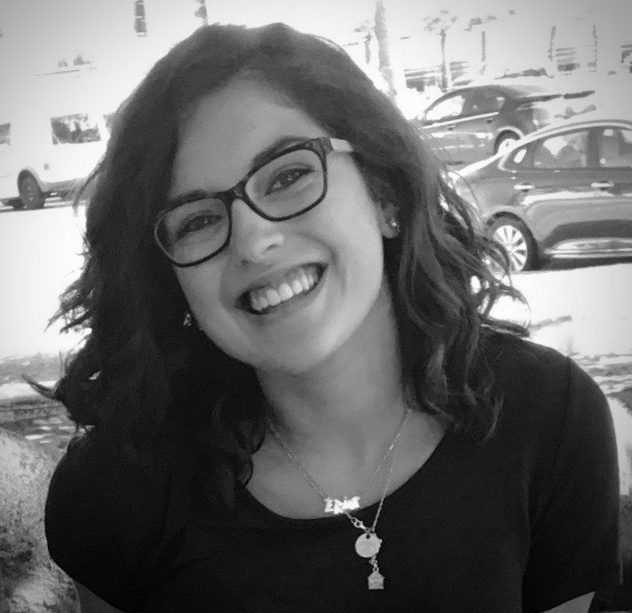
It’s not even December and it’s beginning to look a lot like Christmas. Everywhere you go. It’s hard to compete with a holiday that takes over shopping centers, radio stations and coffee cups. Jews are lucky if there is a dedicated nook for Hanukkah goodies.
Jewish rabbi and entrepreneur Yael Buechler knows this struggle, and has made a career designing and selling cute and trendy apparel for those yearning for some Jewish holiday spirit.
Established in 2012, Buechler’s business, Midrash Manicures, sells thousands of nail decals, scrunchies, leggings and sweaters every year for every Torah parsha and holiday in the Jewish calendar. She even sold Band Aids with Yiddish phrases for a limited time.
For 20 years, Buechler has been notorious for painting Jewish nail art depicting biblical and holiday themes for friends and students. A rabbi at The Leffell School (formerly Solomon Schechter School of Westchester) in New York, she created a Midrash Manicures class where students decorated their nails according to the weekly Torah parsha. Her Jewish-themed products have also gained attention from Jon Stewart, Barry Manilow and the late Supreme Court Justice Ruth Bader Ginsburg.
Her goal is for Jewish women to proudly wear their Judaism year round especially during holidays. The pandemic this year changed everything, including the way Jews gather. Buechler teamed up with New Yorker cartoonist Hillary Fitzgerald to create holiday-themed cards for Rosh Hashanah and Hanukkah as a way for people to connect when meeting in person isn’t an option. She also created a new COVID-19-friendly Hanukkah fanny pack so people don’t have to leave their sanitary essentials behind.
The Journal spoke with Buechler on the phone to discuss Hanukkah, the pandemic and how to redefine one’s Jewish identity while wearing a bagel scrunchie. The interview has been edited for clarity.
Jewish Journal: Right now, all I see online are manicure kits and sticker manicures. You’ve been doing this for years already.
Rabbi Yael Buechler: Exactly. I’ve been doing nail art since before it was cool. It sort of fell on me, actually. I was doing it for myself for many years for the Torah portion and then for Jewish holidays and other themes on my own, and friends would ask if I could do their nails, but eventually I started almost ten years ago, actually. It just took off. People were asking. “Where can I buy these?” I said, “They’re painted on my nails.”
There was definitely a demand out there for some sort of a product. I had gone to rabbinical school. I didn’t go to business school, so this was certainly interesting, being a Jewish entrepreneur and learning about all the effort that goes into creating an amazing product.
JJ: When did it click with you that you could go beyond the manicures, like fun, creative, fashionable Jewish apparel, not just hokey ugly menorah sweaters?
RYB: I think it dawned on me because it was something I wanted for myself. Again, I’m always thinking about how I can find ways to be able to demonstrate my own excitement about Judaism and model that for people across the world. I’m a rabbi, and so I have a lot of students. I was always thinking how can I demonstrate to them how Judaism is not just about something we study in the Torah and the Talmud, but it’s actually something we can wear.
The Torah literally says “Let it be a sign upon your hand.” We have other foundational understanding that Judaism is something that can be worn, and it feels to me that it’s not just about learning, but it’s about making your own meaning of Judaism and that can be through outer expression. That can be through something you wear. That can be through something you listen to music-wise. There are so many ways to celebrate our own Judaism.
JJ: We’re still trying to break out of this idea that rabbis and Judaism are only for men, and women are just on the sidelines. I think there’s something so amazing seeing female rabbinical leadership giving something to women for them to own their creative Judaism.
RYB: When we typically think of Jewish garb, I might head toward a blue and white tallit or other typical things like tefillin, and yet there’s so much out there even outside the official ritual world. Why not be able to wear your own argyle dreidel dress? There are so many other ways to celebrate Judaism aside from what we would do in a synagogue setting.
When I found a lot of the Judaica out there, they were very traditional prints. Midrash Manicures prints are much more vibrant, a breath of fresh air to modern design. If you have argyle print and a dreidel that the argyle’s in, that’s cool. It’s not your bubbe’s Judaica. It’s been particularly meaningful this year for the millennials. This is something that works for them and fits into their own Jewish identity because often we’re not, as a generation, always super excited to affiliate or connect with traditional institutions. So, we find other ways to embrace our own Judaism, and this is one way in which people can do that.
JJ: Especially now in a pandemic where we can’t rely on our institutions and our traditional forms of spiritual gathering in order to be Jewish. Do you feel this is another way to be spiritually connected to your religion without having to jeopardize your health?
RYB: Yes. This is a way to also be connected to the Jewish community and to your community in general. I remember that every Rosh Hashanah we’d get tons of cards. I remember getting my hands sore from hole-punching and hanging them in our sukkah. We only got a few cards this year. Cards are sort of not in. I attempted at Rosh Hashanah [to design cards.] I work with this amazing cartoonist, Hillary Fitzgerald Campbell. I followed her on Instagram, and she’s great. We just clicked. She’s not Jewish—she has a lot of Jewish friends—but we were able to vision with each other and figure out what it is that would work for the cards.

I think part of it is how do we create something that enables people to smile but that isn’t taken the wrong way. She’s great, and we created a design for Rosh Hashanah, and I didn’t really know what would happen next. I was hoping it would make Rosh Hashanah cards cool again, and I really think it did based on how many we sold. There were a lot. I think that was really powerful and cool to see that we could make a difference. Sometimes we need to go to an old-school model, literally reaching out with a note and saying, “We’re here for you. We’re thinking of you,” and saying, “Hanukkah sameach,” “Happy Hanukkah.” The winter holidays will be much tougher for everyone.
JJ: Everybody’s saying that, and you’re here with happy, fun, lighthearted but also very functional products. Why do you think the fanny pack is making its comeback and why was that something that you really wanted to personalize with a Hanukkah theme?
RYB: First of all, fanny packs are amazing and it’s a bummer that they haven’t come back sooner because no one makes pockets for women, so that’s been great. I also tend to typically wear dresses, so I think having a fanny pack is super helpful. I would say I think part of it was thinking about what during a pandemic would be most helpful in order to create something that is meaningful and helpful at the same time.
For me, I celebrate Hanukkah in July. That’s sort of like Christmas in July. I think about all the things I want to design for Hanukkah every summer, and the fanny pack seemed like such an obvious choice given that everything we were doing involved Purell and gloves and not always holding your phone. I wear a fanny pack every day right now and people are welcome to wear them however long they want, but it’s really helpful to have that right now.
I do follow fashion trends and season trends. I would like to say I had a seasonal scrunchie before [it was cool.] I think I’m paying attention to what it is that people want to wear, and why not find opportunities to make those items celebrate Judaism?
JJ: On your website, you encourage creative religious expression. I love that you’re putting it out there. Did this experience of Midrash Manicures help re-identify any parts of your Jewish journey?
RYB: I grew up as the daughter of a rabbi in an observant home, with most of my life within the Jewish community itself in different varieties. I always felt like I didn’t have female role models in my life in terms of Jewish leaders, and I think it was important for me to be able to say, “I want to be a rabbi and I want to be a future role model to someone like me,” and create my own way of celebrating my Judaism through my nails after studying the Torah portion.
I think what Midrash Manicures has shown me is that there’s a lot of people that are very willing and excited to engage in creative expression for their Judaism, but my hope is that it would spark other ideas for other women and other Jews to find ways to celebrate their Judaism and to express their Judaism in new ways.
JJ: What pattern has been on your list to try?
RYB: The fanny pack [Hanukkah design] is a pattern that I had done on leggings, which I absolutely love, so that is another way. I wanted to do a fanny pack, so for me it was a transfer of the pattern. The argyle dreidel pattern, I worked so long to make that happen. I think that was my goal in Jewish patterns. I’d love to see that on other products, too, but it was a very long process, a dream of a pattern, and it fit. I knew I could visualize it and then finally see it on the dress, it was just so cool. 
JJ: Is Hanukah your busiest time of year?
RYB: I assumed it would maybe be Hanukkah, but actually some years it’s been Passover; the Ten Plagues decal just took off. I think for families, they’re often buying things to have at their Seder, and it just worked, so that’s been a really busy time of the year. Also, there are other holidays that don’t have as much of, I guess you’d say, a reason to go out and get things, so I have High Holiday nail decals, and for many people, that’s their way of getting ready for Rosh Hashanah, by putting an apple, honey, and other symbols on their fingers.
I love being able to think about new ideas all the time, even just the idea of making a scrunchie. That just had not been done in the Jewish community before and now there are many. We one with bagels on them, and we have one for Hanukkah and things like that. We even have one with pomegranate seeds for Rosh Hashanah. Then I sent a sample to RBG. She wrote back saying she’s wearing it around. That was probably the highlight.
JJ: RBG had your merch?
RYB: Yep. Now I have the letter hanging in my office. It’s my biggest accomplishment.
JJ: What was your reaction to her passing?
All I could say is that a light just burned out, and we have an opportunity and an obligation to do everything we can to honor her memory right now. There were over 220,000 people that weren’t able to vote because they’re not living. In her memory, how do we honor their legacy? How do we represent what they might have wanted? Those are big questions for me, and I think that Judaism does teach us about our role in terms of obligations for our own communities and for the world.
JJ: With Biden now our president elect, does this change the feelings you have going into the holiday season?
RYB: I think that now that the election season is behind us, we can all breathe a sigh of relief and begin to think about Hanukkah. Hanukkah this year will certainly look and feel different but I’m excited for the creative possibilities of Hanukkah celebrations on Zoom, Facebook and Instagram.
My hope is that our new shamash, President-elect Biden, will bring much-needed healing to our nation. I was excited to have the chance to paint my nails in honor of Vice President-elect Harris. The process of choosing a design to paint was a bit cathartic. I went with a pearl themed french manicure and couldn’t resist throwing in a gnat (from my Ten Plagues Nail Decals set) as an ode to the fly that joined us at a recent debate.
JJ: You said Judaism isn’t just kept within, it literally takes over your body and is acted on through your voice, through your hands, through every part of you. That’s what you try to do with your products. What does it meant to you that you can pass around your products like they’re extensions of the Jewish culture and traditions?
RYB: Many of us were new immigrants to America in the early 20th century. We spent a lot of time trying to fit in with the Joneses, right? But I think now is an opportunity for us—and throw in American consumers—you can wear a real American style by wearing our Jewish holidays. I think there’s a huge piece to that that now is our opportunity to both be American and be Jewish. I think we’re constantly figuring out what that means, but I think the Midrash Manicures has certainly played a role in that.























 More news and opinions than at a Shabbat dinner, right in your inbox.
More news and opinions than at a Shabbat dinner, right in your inbox.